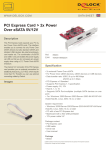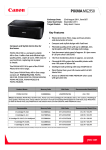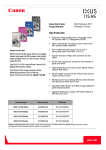Download User Manual - Schulz Electronic GmbH
Transcript
User Manual LDP-V 80-100 V3 Distributor: = = = máÅçi^p=dãÄe `çãé~åó=Ñçê=fååçî~íáîÉ=mçïÉê=bäÉÅíêçåáÅë=~åÇ=i~ëÉê=qÉÅÜåçäçÖó= = h~áëÉêëíê~ëëÉ=NMM= RONPQ=eÉêòçÖÉåê~íÜ= Rev. 15.02 Table of Contents How to get started.....................................................................................................................................4 How to connect the LDP-V 80-100 V3 ....................................................................................................5 Operating Range Diagram........................................................................................................................6 Maximum Duty Cycle vs. Output Current ...............................................................................................8 Current Droop vs. Pulse Duration ............................................................................................................8 Internal Structure of the LDP-V ...............................................................................................................8 How to use the Internal HV-DC-Supply ..................................................................................................9 Pulse Output ...........................................................................................................................................10 Trigger Input ..........................................................................................................................................10 Trigger-Output-Monitor .........................................................................................................................12 Absolute Maximum Ratings...................................................................................................................12 Mechanical Details of the Base-Plate .....................................................................................................13 2 3 How to get started Step # What to do Check 1 Unpack your Device 2 Make a short at the output 3 Turn the High voltage to the lowest value (turn poti fully counterclockwise) 4 Connect a Pulse source with the desired pulsewidth to the selected triggering Input 5 Connect your Scope Select 50 Ohm termination, trig on neg. falling edge, 200 mV/div. 6 Apply the supply voltage Security Advise: Do not touch any leads of the output or the output capacitors as they are connected to a high voltage of up to 100 V. Connect a 15 V DC power supply to the pinheader. See page 5 for details. Note: Some supplies have a voltage overshoot during turn on/turn off. This may damage the device. 7 Adjust the value of the desired pulse current. (turn the poti clockwise until the current reaches the desired level.) 8 Disconnect the supply, remove the short at the output and assemble the Laser Diode (Polarity!) 9 Reconnect the Supply and check the optical output of your Laser Diode. 4 e.g. 100 ns, 100 Hz reprate. Note: The actual current is always some percent lower than the value of step 7. Adjust the current with help of the poti. How to connect the LDP-V 80-100 V3 pçäÇÉêJàìåÅíáçå=íç=~Åíáî~íÉ= íÜÉ=áåíÉêå~ä=esJëìééäó= oçÖçïëâáJ`çáä= mçíá=íç=~Çàìëí=î~äìÉ=çÑ=esJa`= máå=NM= máåÜÉ~ÇÉê= máå=O= i~ëÉêJaáçÇÉJ= `çååÉÅíáçå= Connections via Pinheader: qêáÖÖÉêJfåéìí= Pin Name Description pj`= 1 GND Ground return 2 HV+ `ìêêÉåíJãçåáíçêJçìíéìí= áåíç=RM=lÜã== External high-voltage supply Input (0 .. 100 V) for connecting an alternative HV-DC supply. See page 9 for details. 3 GND Ground return 4 +15 V Supply Voltage, connect to a power supply. 5* Disable_Poti Disables the internal HV-setpoint poti when set high. 6 Pulse_In Trigger Input into 50 Ohm 7 Disable Disables the Pulser when set high. 8* U-Monitor High-volage monitor output (scale: 40 mV/V) for supervising the actual high voltage. 9 NTC Internal 10 kOhm NTC versus GND for temperature monitoring. (B-value: 3620) 10* Ext_HV_Setpoint External HV setpoint input (scale: 25 V/V) allows control over the internal HV-DC source. *These pins had to be left unconnected in older versions then V3 Trigger Input: The trigger input requires a signal level of 5 V and is terminated with 50 Ohm. Current Monitor Output: The current monitor output has a scale of 40 A/V with a negative signal output. It has a source impedance of 50 Ohm and must be terminated with 50 Ohm to achieve the correct scale. Laser Diode Connection: The Laser Diode can either be connected via the mounting holes on the top side of the pulser (inner hole: Anode, outer hole: Cathode) or at the rectangular pads on top (Anode) and bottom (Cathode) of the pulser. Security Advise: Do not touch any leads of the output or the output capacitors as they are connected to a high voltage of up to 100 V. 5 Operating Range Diagram LDP-V 80-100 V3: Max. Reprate vs. Pulsewidth (internal HV, with cooling) 10.000 Repetition rate in kHz 1.000 100 10 1 0 100 200 300 400 500 600 700 800 900 1000 900 1000 Pulsewidth in ns 10 A 15 A 20 A 30 A 40 A 50 A 60 A 70 A 80 A LDP-V 80-100 V3: Max. Reprate vs. Pulsewidth (internal HV, without cooling) 10.000 Repetition rate in kHz 1.000 100 10 1 0 100 200 300 400 500 600 700 800 0 Pulsewidth in ns 10 A 15 A 20 A 30 A 6 40 A 50 A 60 A 70 A 80 A LDP-V 80-100 V3: Max. Reprate vs. Pulsewidth (external HV, with cooling) 10.000 Repetition rate in kHz 1.000 100 10 1 0 100 200 300 400 500 600 700 800 900 1000 900 1000 Pulsewidth in ns 10 A 15 A 20 A 30 A 40 A 50 A 60 A 70 A 80 A LDP-V 80-100 V3: Max. Reprate vs. Pulsewidth (external HV, without cooling) 10.000 Repetition rate in kHz 1.000 100 10 1 0 100 200 300 400 500 600 700 800 0 Pulsewidth in ns 10 A 15 A 20 A 30 A 40 A 7 50 A 60 A 70 A 80 A Maximum Duty Cycle vs. Output Current The following tables show the maximum allowable duty cycle depending on a given output current. With active cooling of the baseplate: Output current in Max duty cycle A with ext. HV 5 1 10 0,2889 15 0,1284 20 0,0722 25 0,0462 30 0,0321 35 0,0236 40 0,0181 45 0,0143 50 0,0116 60 0,0080 70 0,0059 80 0,0045 Typical High Voltage in V 7,66 13,71 19,77 25,82 31,88 37,93 43,99 50,04 56,10 62,15 74,26 86,37 98,48 Max duty cycle with int. HV 0,784 0,219 0,101 0,058 0,038 0,026 0,019 0,015 0,012 0,010 0,007 0,005 0,004 Current Droop vs. Pulse Duration The following table shows the absolute output current droop (in A) versus pulse length. Pulse durations shorter than one microsecond are not considered as the droop is typically lower than 5%. Pulse Duration in µs Current in A 1 5 10 5 0,12 0,36 0,6 15 0,4 1,2 2,0 30 1,0 3,0 6,0 50 2,0 6,0 12,0 80 4,0 - Internal Structure of the LDP-V The LDP-V series generates the pulses by a simple but efficient principle. First, the storage capacitors (CS) are charged, whether through the internal HV-DC-supply or an external high voltage source. When a pulse is applied at the trigger input, the high speed mosfet opens and the current flows from the capacitor through the laser diode, mosfet and current sense resistors. At the end of the pulse, the mosfet closes again and the current stops. The generated current depends on the applied high voltage, the laser diode compliance voltage and its differential resistance. The following formulas give a good estimation of the laser diode current depending on the pulser’s high voltage supply UHV, the laser diode compliance voltage Ucomp and its differential resistance Rdiff: 8 I LD ≈ U HV − U comp 1.1 + Rdiff The laser diode current is measured with current sensing resistors (current monitor output) and with the galvanically isolated rogowski coil. Disable- and trigger-input provide full control of the driver’s pulsing capability to the user. The required DC high-voltage can either be applied through an external voltage source or it can be generated with the integrated HV-DC-supply. The internal supply is controlled by the HV setpoint poti or, when the Disable_Poti (Pin 5) pin is set high, via the Ext_HV_setpoint (Pin 10) pin. A voltage monitor (Pin 8) provides feedback of the high dc voltage. The Diode DRP prevents the laser diode from reverse currents; a 10kR NTC provides the possibility to monitor the pulser temperature. An over temperature protection is NOT integrated on the driver. Pin 2: + HV Pin 8: U-Monitor +HV-Adjust-Poti 15 V ++++ Pin 4: +15 V 18 .. 90 V LD Pin 5: Disable Poti DR P ---- Pin 10: Ext. HV setpoint CS Pin 7: Disable RC L Rogowski-Coil Pin 1,3: GND Pin 6: Trigger Trigger SMC Pin 9: NTC 50 R Driver 10K 50 R Current-Monitor RC S Rogowski-Coil How to use the Internal HV-DC-Supply The LDP-V series provides a high power (up to 15 W / 1 A / 100 V) internal high voltage supply. To adjust the laser diode current to the desired value follow the steps below. Notice: Make sure that the solder junction is done to activate the HV-DC-Supply. 1. 2. 3. 4. 5. Turn the poti fully counterclockwise Apply the 15 V supply voltage Start Pulses Measure the diode current Adjust the level of the high voltage supply (hence the level of the current) by turning the poti clockwise Since Version 3 of the LDP-V series, the HV-DC-Supply can also be controlled through an external setpoint signal on pin 10 of the pinheader (Ext_HV_Setpoint); the scale is 25V/V. To enable the external setpoint pin and disable the internal poti, pin 5 (Disable_Poti) of the pinheader has to be set to “high”. Otherwise the internal poti will override the external signal. The high DC voltage can be monitored at pin 8 (U-Monitor) with a scale of 40 mV/V. Note: Older versions are not capable of these features and the above mentioned pins have to be left unconnected! 9 Security Advise: Do not touch any leads of the output or the output capacitors as they are connected to a high voltage of up to 100 V. Pulse Output The LDP-V series provides ultra rapid pulse rise- and fall-times in the region of several nanoseconds. However, pulse rise and fall depend on the parasitic stray inductance of the cabling to the laser diode. Direct connection without any kind of wires to the module is absolutely necessary for best results. For detailed information about the effect of the laser diode connection on the pulse shape please refer to PicoLAS Application Notes #2 and #3. Typical Pulse Rise and Fall Times of LDP-V 80-100 V3 (scale: 10 A/Div) Trigger Input The trigger input, both on the pin header and the SMC-jacket, is terminated with 50 Ohm to ground. The trigger source has to be able to provide a signal level of 5 V with a 50 Ohm load. The delay between the triggering signal and the load-current is very low around 36 ns and very constant. The pulse-to-pulse jitter is very stable below 1 ns if the supply voltage and temperature are kept constant. 10 Typical trigger delay of LDP-V 80-100 V3 11 Trigger-Output-Monitor The Trigger Output signal is generated with an integrated, isolated Rogowski-Coil and provides an ultra fast galvanically isolated signal. The signal shape is proportional to the derivative of the load current. It can be used for a current-response triggering signal and has no delay to the load current. Combined with an integrator it is possible to use this signal for a galvanically isolated current monitor. The isolation barrier is suitable for voltages up to 100 V and prevents unwanted ground loops. Signal of the Rogowski-Coil: "True" load current Positive edge at pulse begin Negative edge at pulse end Absolute Maximum Ratings Supply voltage range: 10 .. 18 V Max. voltage at HV Pin: 100 V Max. output current U-monitor, NTC: 1 mA Input voltage range Disable_Poti, Ext_HV_Setpoint: 0 .. 5 V Input voltage range trigger input, Disable: 0 .. 15 V Storage temperature: -20 .. +85°C non condensing Security Advise: Do not touch any leads of the output or the output capacitors as they are connected to a high voltage of up to 100 V. 12 Mechanical Details of the Base-Plate All dimensions in millimetres. 13


























